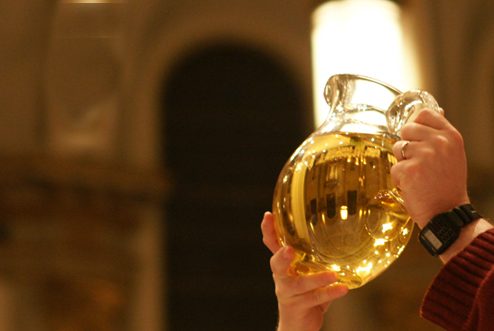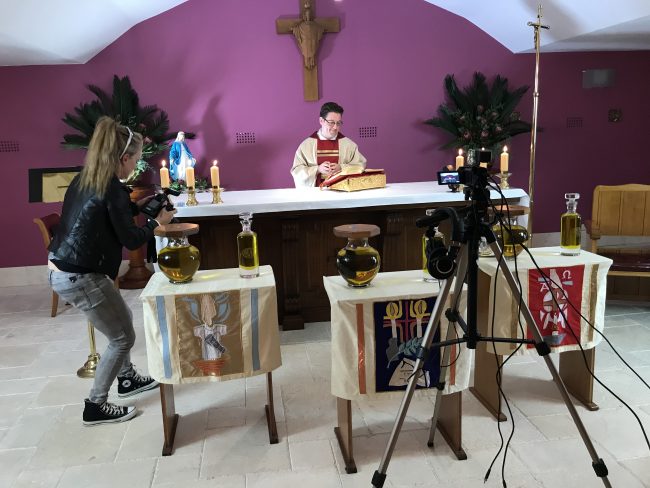Chrism Mass – Live streamed at 11am today

CLICK HERE>>> to view the live stream on our YouTube channel at 11am today.
What is the significance of the Chrism Mass?
During Holy Week, traditionally the bishop, joined by the priests of the diocese, gather at the Cathedral to celebrate the Chrism Mass. This Mass manifests the unity of the priests with their bishop. Due to the current COVID-19 restrictions on public masses and gatherings, Archbishop Christopher will celebrate the Chrism Mass from the crypt at St Christopher’s Cathedral with fewer than ten people including readers and those involved in filming, to be in the room.
The Archbishop will bless three oils — the oil of catechumens (oleum catechumenorum or oleum sanctorum), the oil of the infirm (oleum infirmorum) and holy chrism (sacrum chrisma) — which will be used in the administration of the sacraments throughout the diocese for the year.
Throughout the Bible, various references indicate the importance of olive oil in daily life. Oil was used in cooking, particularly in the making of bread, that basic food substance for nourishment (e.g. Nm 11:7-9); as a fuel for lamps (e.g. Mt 25:1-9); and as a healing agent in medicine (e.g. Is 1:6 and Lk 10:34). Moreover, with oil the Jews anointed the head of a guest as a sign of welcome (e.g. Lk 7:46), beautified one’s appearance (e.g. Ru 3:3) and prepared a body for burial (e.g. Mk 16:1).
The Oil of Catechumens is used in connection with the sacrament of baptism. St. Hippolytus, in his Apostolic Tradition (A.D. 215), wrote of an “oil of exorcism” used to anoint the candidates immediately before baptism. This practice continues: In the current baptismal liturgy, the priest offers the prayer of exorcism and then with the oil of catechumens anoints the person to be baptized on the chest, saying, “We anoint you with the oil of salvation in the name of Christ our Savior; may He strengthen you with His power, Who lives and reigns forever and ever.”
The oil of the infirm is used in the sacrament of the anointing of the sick (formerly known as extreme unction). St. James wrote, “Is there anyone sick among you? He should ask for the priests of the Church. They, in turn, are to pray over him, anointing him with oil in the name of the Lord. This prayer uttered in faith will reclaim the one who is ill, and the Lord will restore him to health. If he has committed any sins, forgiveness will be his” (Jas 5:14-15).

Cathedral Administrator, Fr Trenton van Reesch is photographed by the Canberra Times as he prepares the Crypt at St Christopher’s Cathedral for the Live streaming of the Chrism Mass
Finally, holy chrism is a mixture of olive oil and balsam, an aromatic resin. This oil is linked with the sanctification of individuals. In the Old Testament times, the priest, prophets and kings of the Jewish people were anointed. This oil is used in the sacraments of baptism, confirmation, and holy orders, since they impart an indelible sacramental character. The blessing of the holy chrism is different from that of the other oils: Here the bishop breathes over the vessel of chrism, a gesture which symbolizes both the Holy Spirit coming down to consecrate this oil, and the life-giving, sanctifying nature of the sacraments for which it is used. (Recall how our Lord “breathed” on the Apostles on the night of Easter, saying, ‘Receive the Holy Spirit’”
Regarding baptism, St. Hippolytus in the Apsotolic Tradition spoke of an anointing after the actual baptism with the “oil of thanksgiving.” Similarly, right after the actual baptism in the present rite, the priest anoints the person on the crown of the head with chrism, saying, “God the Father of our Lord Jesus Christ has freed you from sin and given you a new birth by water and the Holy Spirit. He now anoints with the chrism of salvation. As Christ was anointed Priest, Prophet and King, so may you live always as a member of His body, sharing everlasting life. Amen.”
In the sacrament of confirmation, the bishop anoints the forehead of the candidate with chrism saying, “Be sealed with the gift of the Holy Spirit.”
Sacred chrism is also used in the sacrament of holy orders. In the ordination rite of a priest, the bishop anoints with chrism the palms of each new priest. In the ordination rite of a bishop, the consecrating bishop anoints the head of the new bishop.
Finally, holy chrism is used in the dedication ceremony of a church. Here the bishop anoints the altar, pouring holy chrism on the middle of the altar and on each of its four corners. It is recommended that the bishop anoint the entire altar. After anointing the altar, he anoints the walls of the church in 12 or four places marked by crosses.



Thank you so much for live streaming the Mass each day. It is very much appreciated. However I was disappointed the parts of the Mass were in Latin as most of us don’t understand it. It would better for us all if the Mass was in English as public worship.